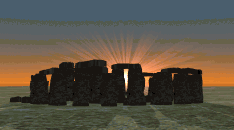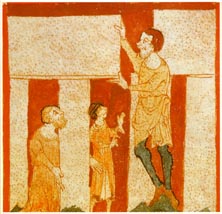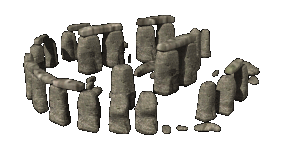





HOME
|

|

|

|

|
|
P R O F I L E |
||||
|
  STONEHENGE - ancient Oracle and Healing Centre
STONEHENGE - ancient Oracle and Healing CentreNear Amesbury Wiltshire United Kingdom Was Stonehenge the location in an ancient developed landscape where tribal dignitaries came to consult an Oracle or Prophet on matters relating to the future and on physical and mental wellbeing? Was it the forerunner of the ancient Greek grotto where psychic communication through a gifted intermediary gave messages from the Gods? Dr Bruce Osborne discusses this speculation.PREAMBLE Located on the A303 Trunk Road, 8 miles north of Salisbury, Stonehenge is a world famous, unique ancient monument. It comprises a series of circles enclosing two series of standing stones in the shape of a horseshoe. It is located in a landscape that contains a profusion of ancient monuments and earthworks in the immediate vicinity. Evolving over thousands of years its provenance has perplexed historians and archaeologists since its abandonment a thousand years before the Romans conquered Britain. As our understanding of Stonehenge and its landscape improves, so new theories emerge as to its purpose for the ancient communities that built and used it. Modern scholarship now sees it as a place of an Oracle, a forerunner of the famous Oracle at Delphi. It is also postulated that it was a place of healing, both spiritual and bodily. However a more detailed study of astrology leads to the hypothesis that Stonehenge was a place of birth and death, a portal whereby the spirit could emerge from or return to the supernatural eternity. 
Illustration: Merlin at work at Stonehenge from a 14th century manuscript. Of relevance to the interpretation of early belief systems associated with Stonehenge is the work of W A Cummings. In his book "King Arthur's Place in Prehistory - The Great Age of Stonehenge" (1992) Dr Cummings looks at ancient writings in order to provide clues to determining the role of King Arthur but more importantly for this debate, in evaluating the religious role of the structure. In particular Geoffrey of Monmouth's "Historia Regum Britanniae" of 1136 is revisited and this leads to clues about a prehistory age that had previously been recorded by word of mouth. Such works as "Historia Brittonum" by Nennius and "Annales Cambriae" or Gildas in "De Excidio Britonum" all add flesh to the bones of interpreting in modern terms the role of Stonehenge as a commanding religious centre for a dispersed society. The ancient Greek connection between the Hyperboreans (British) is debated and concludes a regular dialogue existed. This in turn leads to the link between the two locations on issues such as the cult of Apollo and the related oracular belief system. In fact it is suggested that the Hyperboreans introduced the Greeks to the worship of Apollo. A magnificent temple and sacred precinct to Apollo existed in Britain possibly referring to Stonehenge or the Temple of Ambrius as it was known in prehistory. Cummings then goes on to debate the creation and ultimate demise of Stonehenge, the role of Merlin the architect and the rise and fall of Wessex Culture. The site is open to the public and managed by English Heritage. It is a World Heritage Site and one of the Wonders of the World. It can be reached from London by car in about 2 hours. Website: Click Here ADDITIONAL INFORMATION 
Stonehenge - the grotto of the Oracle?
Stonehenge 'No Place for the Dead',
says Bournemouth University Expert Evaluating the theory
With more than a million visitors a year journeying to
Stonehenge, it is little wonder that intense interest prevails regarding its
origins and purpose. The monument is unique in that it has no comparable
structure elsewhere in the world and has yet to be understood in terms of its
cultural and social role in the communities that it served over many thousands
of years. As our knowledge of the monument and The land of the Hyperboreans was the locality now generally recognised as the British Isles by the ancient Greeks. Around the year 330 BC the Greek historian Hecataeus of Abdera made brief mention of temples and sanctuaries in this land. The original text is long lost however extracts survive in later histories such as the Bibliotheca Historica by Diodorus Siculus around 8 BC. (Darvill p.32) According to Hecataeus, Leto was born on this Island and for that reason Apollo was honoured amongst the populace. A spherical temple, sacred precinct and a city existed to the god. Greeks visited the Hyperboreans and left behind votive offerings. The moon in this land was said to have great prominence and the God visits the land every 19 years. when the stars return to the same place in the heavens. (Darvill p.35) Unscrambling the various strands of information embedded in this second generation text a number of salient points emerge. Apollo was a sun god of uncertain age, (albeit generally cited to have existed in the 1st millennium BC.) He did have earlier incarnations however. In addition he is believed to have spent much of the year in Delphi but for the winter solstice travelled northwards to the land of the Hyperboreans. (Darvill p.35)
Following the last glaciations of the ice age, northern Europe
was recolonised from the south and east during the 13th millennium BC
and thereafter. The English Channel did not exist and England was an extension
of the northern European plains. The climate warmed and stabilised sufficiently
to allow vegetation and wild life to establish. Climatic changes resulted in sea level rises and the British Isles took on its modern day geographical isolation from mainland Europe about 7000BC. It was not until about 4000 BC that the environment was opened up by man and mature cultural objects started to appear. The physical isolation however meant that the technologies and culture were somewhat insular and regionalised. Evidence exists however to show that European connections were maintained and domestic animals of this time have been shown to have originated in Europe. By the 4th millennium it is apparent from archaeological evidence that the local populace had long distance contacts with contemporary artefacts being traced to The Lizard in Cornwall for example. A Jade axe originated in the Alps. (Darvill p.65,70,75,92) This period triggered the more extensive development of Stonehenge and the surroundings, leading to the landscape and evolving, complex structures that we would recognise today during the 3rd and 2nd millennium BC. Leaving aside the detail of the remodelling of Stonehenge over this period, what is apparent is that great significance was placed on the locality over an extended period of time. (Darvill p.127) One important aspect of the evolution of Stonehenge is the celestial alignments. These are apparent early in its evolution and are perpetuated in the subsequent development stages of the Stonehenge monument. Although detailed astronomical alignments to the stars are open to debate, the sun alignments with the summer and winter solstice and moon alignments with the Station Stones giving the 18.6 year moon elevation cycle are now generally accepted. Darvill endorses Burl's speculation that the presence of the Heelstone for the solar alignment may well have been the reason for locating Stonehenge where it is. Any device that provides firm confirmation of precise markers in the passage of time is invaluable for the organising of festivals and other key events. (Darvill p.100, 122, 143) One conundrum still providing tantalizing questions is the origin of the Bluestones. Now proven to have originated in Pembrokeshire, why should such stones be transported over such a long distance? The Bluestone Oval is matched by a similar structure at Bedd Arthur, Pembrokeshire, overlooking the Bluestone outcrops of Carn Menyn in the Preseli Hills. In fact many of the features of Stonehenge are similar to circles and monuments elsewhere but none match the complexity. The Preseli Hills themselves were an area of extensive human activity during the period of Stonehenge building and remodelling, with circles and monuments in profusion. This was the site of extraction of the Bluestones, some 400km + from Stonehenge. One suggestion for the sourcing of such stones was that they carried healing qualities. They were certainly valued and reused for major reconstruction over an extended period. (Darvill p.119-121, 128, 139-141)
The idea that Stonehenge was some form of temple over much, if not all of its active life is generally accepted. It is now established that it was in a sanctuary area away from the general living areas of the local populace. A feature of the sanctuary area was the numerous works and monuments to the dead and this has given rise to speculation that it was some form of depository for the dead. Other interpretations include the possibility that it was the domain of the spirits of the dead and was empowered as a result. (Darvill p.141, 155)
The value of the sun and moon
It is postulated that Stonehenge was an Oracle. This was a place where people gathered to contact the supernatural; to find out about their own destiny and seek assistance in overcoming their trials and tribulations, especially healing. Unlike other temples, Oracles respond to enquiry. Their concept was well established from the 3rd millennium BC. It is suggested that the gods of the Oracle were the early incarnations of what was later in the 1st millennium BC to become Apollo and Artemis. Apollo particularly, the greatest of Oracles represented a broad spectrum of divination with both prophecy and healing and was to be later established at Delphi. Apollo travelled to the land of the Hyperboreans in winter. Those seeking consultation would not have wanted to miss his occasional visit, hence the importance of the celestial alignments within the architecture. (Darvill p.146) By about 2000 BC this part of Britain had secured a substantial reputation based on Stonehenge and practices associated with it. Mobility of population for pilgrimage, trade or whatever should not be underestimated and the Amesbury Archer is cited as an example, journeying from the Alps. In addition small personal items of scanty exotica testify to the acquisition of souvenir objects from distant lands. The clustering of burials around Stonehenge may well have reflected the movement of wealthy people to the monument as a beacon of hope for their failing health amongst other things. (Darvill p.156, 158, 175)
As the 2nd millennium BC progressed the power of
Stonehenge diminished. Changes in society meant that humankind moved on. Perhaps
these changes were the result of short term
Whilst the above text seeks to precis the salient points, the
original text with its detailed source referencing should be referred to by
serious scholars. However there is no mention of Preseli sacred springs in the
book text. This appears to be in media coverage based on comments at the meeting
of the Society of Antiquaries in London. October 2006, when Timothy Darvill
presented his new book. There is also mention of the Preseli Springs in
information from the University of Bournemouth.
CONSTRAINTS Open set times only FACILITIES Access all Year, Access by Road, Entry Fee LANDSCAPE Quality Natural Environment, Rural REGION England - Southern |
||||
|